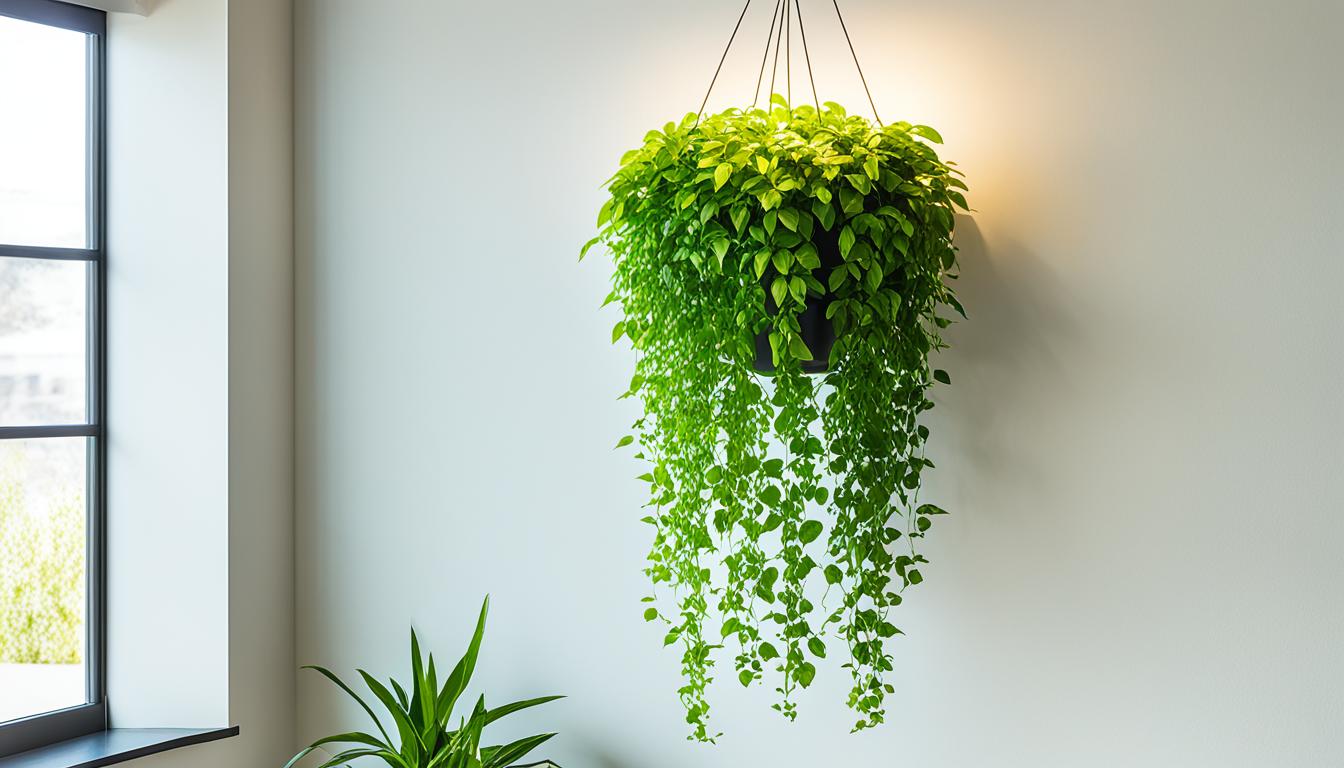Adding indoor plants to your living space can completely transform the atmosphere and create a serene and refreshing environment. Whether you have a large house or a small apartment, indoor plants can bring life to any room with their vibrant colors and lush foliage. In this article, we will guide you through the process of revamping your space with indoor plants, including tips for care and the best varieties to choose from.
Indoor gardening has become increasingly popular as more people recognize the benefits of bringing nature indoors. Not only do indoor plants improve the aesthetics of your home, but they also purify the air by reducing toxins and increasing oxygen levels. With the right care and attention, your indoor plants can thrive and become a beautiful and integral part of your interior design.
Key Takeaways:
- Indoor plants can transform your living space and create a serene atmosphere.
- They enhance the aesthetics of your home and bring nature indoors.
- Indoor plants can purify the air and increase oxygen levels.
- Caring for indoor plants requires attention to watering, lighting, and general care practices.
- Choosing the right plants for your space is essential for their successful growth.
The Art of Table Styling with Indoor Plants
When it comes to indoor plant decor, one area that often gets overlooked is table styling. The right selection and arrangement of plants and pots can create an eye-catching display that adds a touch of nature to your table setting. Whether you’re planning a dinner party or simply want to elevate the look of your dining area, mastering the art of table styling with indoor plants is a must.
Here, we will provide you with essential indoor plant tips and a comprehensive guide to help you create stunning table displays. From choosing the right planters to experimenting with creative decorations, we’ll cover all the necessary steps to transform your table into a botanical masterpiece.
Choosing the Right Planters
The first step in table styling with indoor plants is selecting the perfect planters. Consider the overall decor theme and color scheme of your space to ensure a cohesive look. Ceramic planters are a popular choice as their sleek designs complement various interior styles.
Additionally, don’t be afraid to mix and match different sizes and shapes of planters to add depth and visual interest to your table display. Opt for planters with drainage holes to promote healthy plant growth and prevent waterlogging.
Creative Decorations and Accents
Achieving indoor plant decor on your table goes beyond the plants themselves. Get creative with decorations and accents to enhance the visual appeal of your display. Here are a few ideas:
- Include decorative pebbles or stones around the base of each plant to add texture.
- Opt for plant stands or risers to elevate certain plants and create visual hierarchy.
- Introduce natural elements like driftwood or bamboo for an organic touch.
- Consider incorporating small LED lights to add a magical ambiance to your table setting.
Remember to strike a balance between the plants and the decorations, ensuring that the plants remain the focal point of your table display.
Placement and Exposure
The placement and exposure of your indoor plants play a crucial role in table styling. Consider the natural light conditions of your space and arrange the plants accordingly. Some plants thrive in bright, indirect light, while others prefer more shade.
Proper spacing between plants is also essential to allow them to grow and flourish. Avoid overcrowding the table, as it can make the display look messy and hinder the plants’ growth.
Finally, regularly rotate your plants to ensure equal exposure to sunlight and prevent them from leaning towards one direction. This will contribute to a balanced and healthy table display.
Follow these step-by-step instructions and tips for creating a stunning table display with indoor plants, and watch as your dining area transforms into a lush and inviting sanctuary.
Choosing the Right Plants for Your Space
When it comes to indoor plants, selecting the right ones for your space is essential to create a harmonious and thriving environment. Several factors, such as size and lighting conditions, play a crucial role in determining which plants will flourish indoors. To help you make the best choices, we have compiled a list of the best indoor plants for different spaces, along with guidance on their care requirements.
The Best Indoor Plants for Different Spaces
Whether you have a compact apartment or a spacious living room, there are indoor plants that will suit your space perfectly. Here are some of the top choices:
- Succulents: Succulents are ideal for small spaces and individuals with busy lifestyles. These low-maintenance plants come in various shapes and colors, adding a touch of elegance to any room while requiring minimal care.
- Ferns: Known for their lush green foliage, ferns thrive in low light conditions, making them perfect for areas with limited natural sunlight. These plants can add a refreshing and tropical vibe to your indoor space.
- Snake Plants: Also known as Sansevieria, snake plants are excellent air purifiers and can tolerate low light and irregular watering. Their upright and striking leaves make them a popular choice for any room in your home.
These are just a few examples of the best indoor plants for your space. Each plant has unique characteristics that make it suitable for specific environments, so consider factors such as natural light availability and your personal preferences when making your selection.
Guidance on Care Requirements
Proper care is crucial to ensure the health and vibrancy of your indoor plants. Here are some general guidelines:
- Watering: Different plants have different moisture requirements. Some prefer to be kept slightly moist, while others prefer to dry out between watering. Research the specific watering needs of your chosen plants to avoid over or underwatering.
- Lighting: While most indoor plants require some amount of natural light, the intensity and duration vary. Pay attention to your plant’s lighting preferences, whether it thrives in bright, indirect light or can tolerate low light conditions.
- Humidity: Some plants, like tropical varieties, prefer higher humidity levels. Consider using a humidifier or placing a tray of water near your plants to create a more favorable environment.
- Fertilizing: Indoor plants benefit from regular fertilization to replenish nutrients in the soil. Use a balanced, water-soluble fertilizer according to the instructions provided.
By understanding and catering to these care requirements, you’ll set your indoor plants up for success and enjoy their beauty and benefits for years to come.
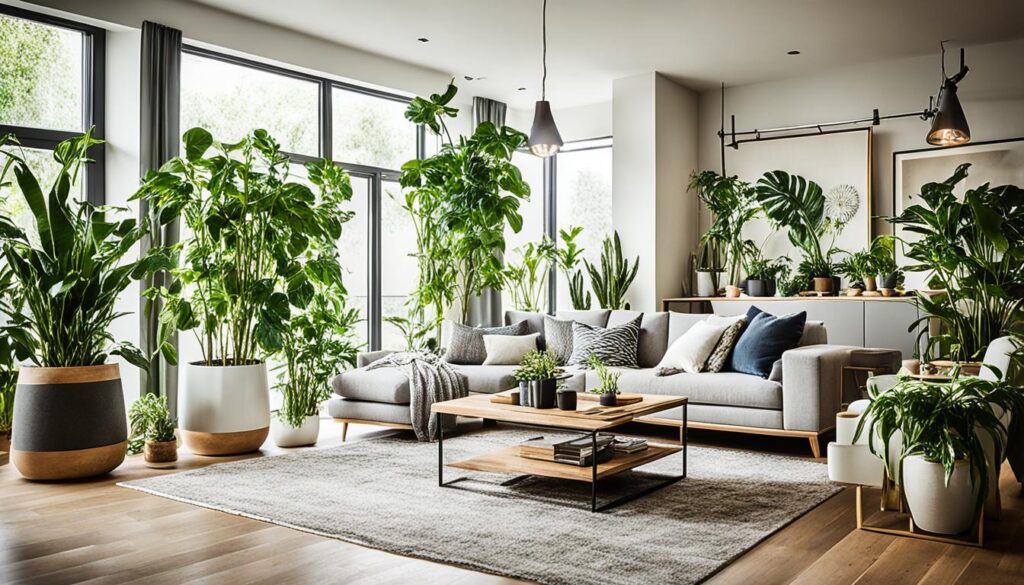
| Plant Type | Lighting Requirements | Watering Needs | Special Care Instructions |
|---|---|---|---|
| Succulents | Bright indirect light | Allow soil to dry between waterings | Avoid overwatering, well-draining soil is essential |
| Ferns | Low to medium indirect light | Keep soil consistently moist | Mist leaves regularly to increase humidity |
| Snake Plants | Low to bright indirect light | Allow soil to dry between waterings | Tolerant of neglect, avoid overwatering |
Selecting the Perfect Pots for Your Table
When it comes to indoor plant decor, choosing the right pots can make all the difference in enhancing the overall aesthetic of your tabletop display. The right pots can complement your table and elevate the style of your indoor plants. Consider the following tips for selecting the perfect pots that not only match your decorative vision but also contribute to the well-being of your plants:
1. Material Matters
When it comes to pot materials, you have several options to choose from. Ceramic pots are a popular choice as they come in a variety of colors and designs. They are great for moisture retention, keeping the soil hydrated for longer. Terracotta pots, on the other hand, provide better drainage and are ideal for plants that prefer a drier soil. Select a pot material based on the specific needs of your plants.
2. Size and Shape
The size and shape of your pots should be in proportion to both the size of your plants and the table you are decorating. Avoid overcrowding the table with pots that are too large or using tiny pots that get lost in the arrangement. Create a harmonious balance by selecting pots that complement the size of your plants and the available space on your table.
3. Color Coordination
Consider the color scheme of your table and the surrounding decor when choosing pots. Opt for pots that complement the overall color palette, whether you prefer matching or contrasting shades. A well-placed pop of color can add visual interest and breathe life into your indoor plant display.
4. Functionality First
While aesthetics are important, don’t forget about the functionality of the pots. Ensure that your pots have drainage holes to prevent waterlogging and root rot. If you are concerned about water stains on your table, consider using saucers or trays underneath the pots to catch any excess water.
| Pot Material | Pros | Cons |
|---|---|---|
| Ceramic | – Wide range of colors and designs – Good moisture retention |
– Can be heavy – More prone to breakage |
| Terracotta | – Excellent drainage – Promotes airflow to roots |
– Prone to drying out quickly – Not suitable for all plants |
Remember, the perfect pots for your table will not only enhance the visual appeal of your indoor plant decor but also support the growth and health of your plants. Choose pots that not only match your style but also provide the necessary functionality for your plants to flourish.
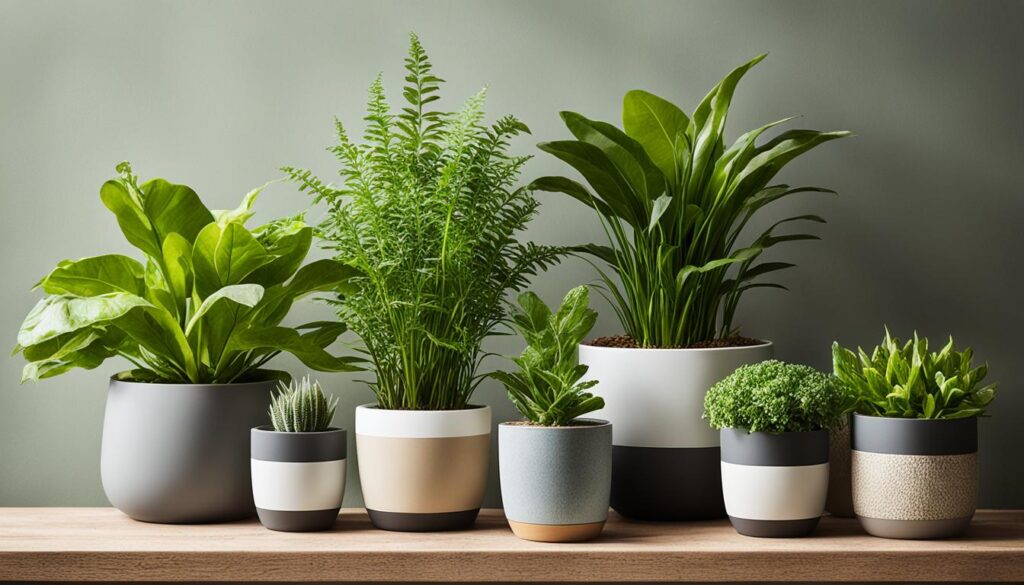
Arranging Indoor Plants for Maximum Impact
The arrangement of indoor plants on your table is crucial for creating a visually appealing and balanced display. When it comes to indoor plant decor, proper arrangement can make all the difference in transforming your space into a lush and inviting oasis. Here are some essential tips to help you arrange your indoor plants for maximum impact:
- Vary the heights: To create depth and visual interest, arrange your indoor plants at different heights. Place taller plants toward the back and shorter ones in the front. This layering effect adds dimension to your display.
- Mix different types of plants: Combining different types of plants with varying textures can create a captivating visual composition. Mix foliage plants with flowering plants or choose plants with different leaf shapes and colors to add variety to your arrangement.
- Consider lighting conditions: Take into account the lighting conditions of your space when arranging your indoor plants. Place plants that thrive in bright, indirect light closer to windows, while shade-loving plants can be positioned in dimmer areas.
Create a Natural Touch with Decorative Items
Enhance the beauty of your indoor plant decor by incorporating decorative items that complement your arrangement. Adding elements like stones, moss, or small figurines can bring a natural touch and further elevate your display. Choose items that harmonize with the overall aesthetic and enhance the ambiance of your space.
Think of your indoor plants as works of art. By arranging them thoughtfully and incorporating decorative elements, you can turn your table into a stunning centerpiece that brings joy and tranquility to your home.
Now that you have the essential tips for arranging indoor plants, let’s take a look at a beautiful example of an indoor plant arrangement:
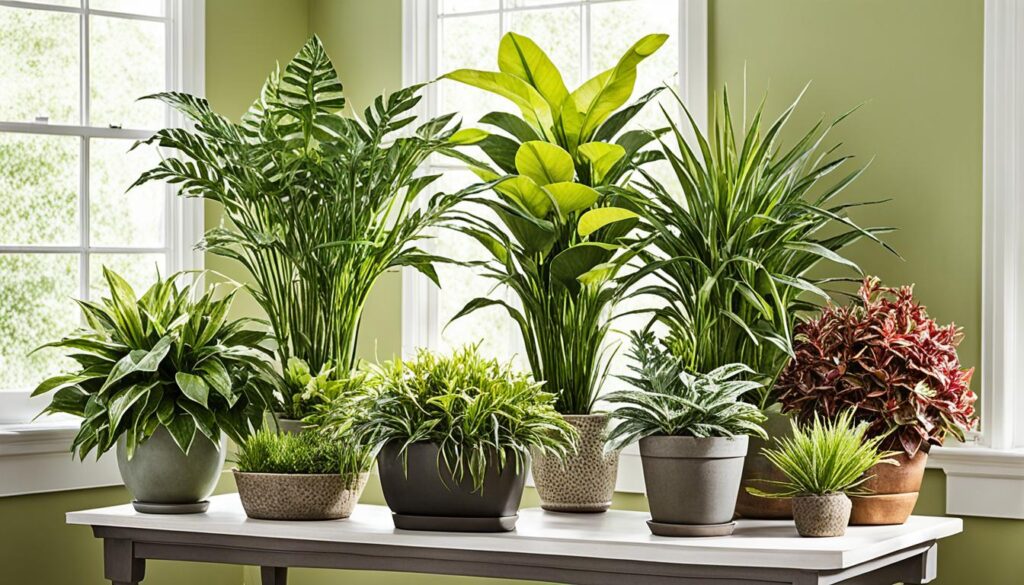
| Plant | Description |
|---|---|
| Monstera deliciosa | A large, leafy plant with signature split leaves that adds a tropical touch to any arrangement. |
| Peace Lily | An elegant plant with dark green leaves and white flowers that thrives in low-light conditions. |
| Sansevieria trifasciata | Also known as the Snake Plant, it features tall, sturdy leaves that add height and contrast. |
| Haworthia | A small succulent with rosette-shaped leaves that adds texture and interest to the arrangement. |
This arrangement showcases a combination of plants with different heights, textures, and light requirements. The Monstera deliciosa provides a striking focal point at the back, while the Peace Lily and Sansevieria trifasciata add contrasting heights and foliage shapes. The Haworthia, with its unique succulent leaves, completes the arrangement by adding a touch of texture and variety.
Remember, the key to arranging indoor plants is to have fun and experiment with different combinations. Let your creativity flow and create a captivating display that reflects your personal style and brings natural beauty into your space.
Maintenance and Care Tips for Indoor Plants
To ensure the longevity and beauty of your indoor plants, proper maintenance and care are essential. Follow these tips to keep your indoor plants thriving:
1. Watering
Watering indoor plants can be tricky. Overwatering can lead to root rot, while underwatering can cause wilting and dryness. Here are some guidelines:
- Check the moisture level of the soil before watering. Stick your finger about an inch deep into the soil, and if it feels dry, it’s time to water.
- Water thoroughly until water starts to drain out of the pot’s drainage holes but avoid letting the plant sit in standing water.
- Establish a watering schedule based on the specific needs of each plant. Some plants prefer to dry out slightly between waterings, while others need more constant moisture.
2. Lighting
Proper lighting is crucial for the health of indoor plants. Different plants have different light requirements. Here are some general guidelines:
- Place sun-loving plants in bright, indirect light near a window where they can receive at least a few hours of sunlight each day.
- Shade-loving plants should be placed in areas with less intense or indirect light.
- If natural light is limited, consider using artificial grow lights to supplement the lighting conditions.
3. General Care Practices
Aside from watering and lighting, here are some additional care practices to keep your indoor plants healthy:
- Regularly dust the leaves of your plants to keep them clean and allow proper absorption of light
- Trim or prune your plants as needed to remove dead or unhealthy leaves, promote growth, and maintain their shape
- Fertilize your plants according to their specific needs. Use a balanced indoor plant fertilizer and follow the instructions on the packaging.
| Common Mistakes in Indoor Plant Care | Solutions |
|---|---|
| Overwatering | Allow the soil to dry before watering again and adjust your watering schedule accordingly. |
| Insufficient light | Move plants to a brighter location or supplement with artificial grow lights. |
| Pest infestation | Identify the pests and treat them with appropriate insecticides or natural remedies. |
By following these maintenance and care tips, your indoor plants will not only survive but thrive in your living space.
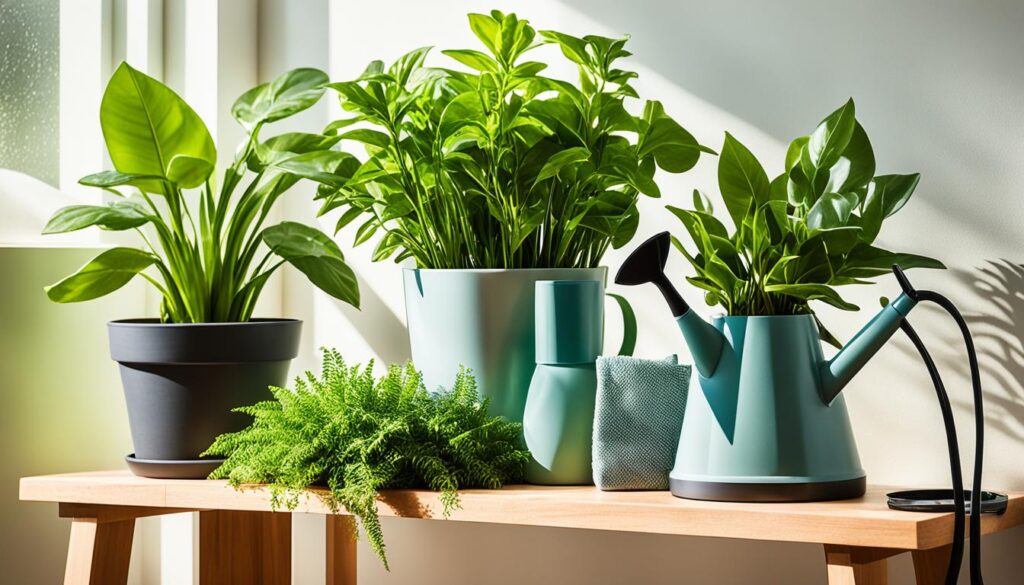
Maintaining healthy indoor plants involves proper watering, lighting, and general care practices. Avoid common mistakes and provide the necessary care to keep your plants thriving.
Benefits of Decorating with Indoor Plants
Decorating your space with indoor plants goes beyond adding aesthetic beauty to your home. The benefits extend to improving indoor air quality, reducing stress, and enhancing mental well-being. Indoor plants have a positive impact on both our environment and overall well-being, allowing for personal expression and creativity in your decor choices.
“Bringing nature indoors through indoor plants has been shown to have a significant positive effect on well-being and mental health. The presence of plants in a space can create a sense of calmness and tranquility, reducing stress levels and promoting relaxation.”
The natural beauty of indoor plants not only adds visual appeal to your space but also contributes to creating a healthier and more harmonious atmosphere. Plants act as natural air purifiers, removing toxins and releasing oxygen, which can have a profound impact on your health and the overall air quality within your home.
In addition, the act of caring for indoor plants can be therapeutic and meditative, providing a sense of purpose and a connection to nature. Engaging with plants can help reduce anxiety and promote a sense of well-being.
Benefits of Indoor Plants:
- Improved indoor air quality: Indoor plants can help remove toxins and pollutants from the air, creating a healthier living environment.
- Reduced stress and anxiety: The presence of indoor plants has been shown to lower stress levels, promote relaxation, and improve mental well-being.
- Enhanced focus and productivity: Studies have indicated that being around plants can improve concentration, memory, and overall productivity levels.
- Boosted mood and creativity: Indoor plants can uplift your mood, promote feelings of happiness, and stimulate creativity, leading to a more positive and inspired mindset.
- Natural sound absorbers: Indoor plants can help decrease noise levels by absorbing and deflecting sound, creating a calmer and more peaceful atmosphere.
Indoor Plants and Personal Expression:
Adding indoor plants to your decor provides an opportunity for personal expression and creativity. You can choose from a wide variety of plants with different colors, shapes, and textures to match your style and preferences. Whether you prefer lush foliage, flowering plants, or unique succulents, indoor plants offer versatility in design and allow you to create a space that reflects your personality.
Furthermore, indoor plants can be incorporated into various decor styles, ranging from minimalist to bohemian, adding a natural touch and bringing life to any room. Whether displayed on shelves, as a centerpiece on a table, or hanging from the ceiling, indoor plants can transform your space into a vibrant and inviting oasis.
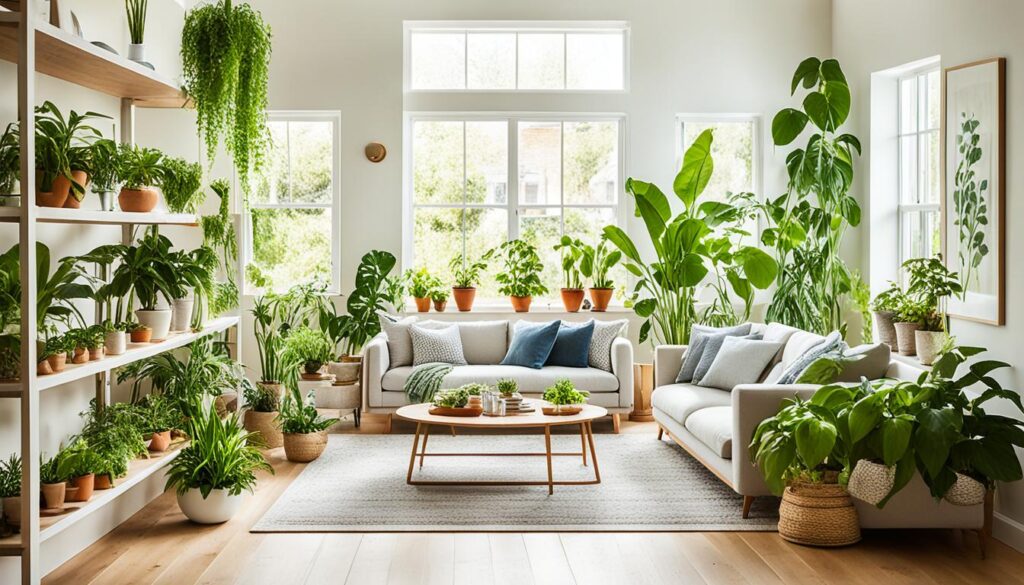
| Benefits of Decorating with Indoor Plants |
|---|
| Improved indoor air quality |
| Reduced stress and anxiety |
| Enhanced focus and productivity |
| Boosted mood and creativity |
| Natural sound absorbers |
Incorporating Plant Design into Your Home
Adding plant design to your home is a growing trend that offers many opportunities for creativity and personalization. Indoor plants not only bring a touch of nature indoors but also add life and vibrancy to any space. Whether you have a small apartment or a spacious house, there are numerous ways to incorporate indoor plant decor into your home.
One popular trend in plant design is creating collections of little plants. These mini gardens can be displayed on tabletops, shelves, or windowsills, allowing you to showcase a variety of plants and create a visually appealing arrangement. Consider combining different types of plants, such as succulents, ferns, and cacti, to add texture and contrast to your collection.
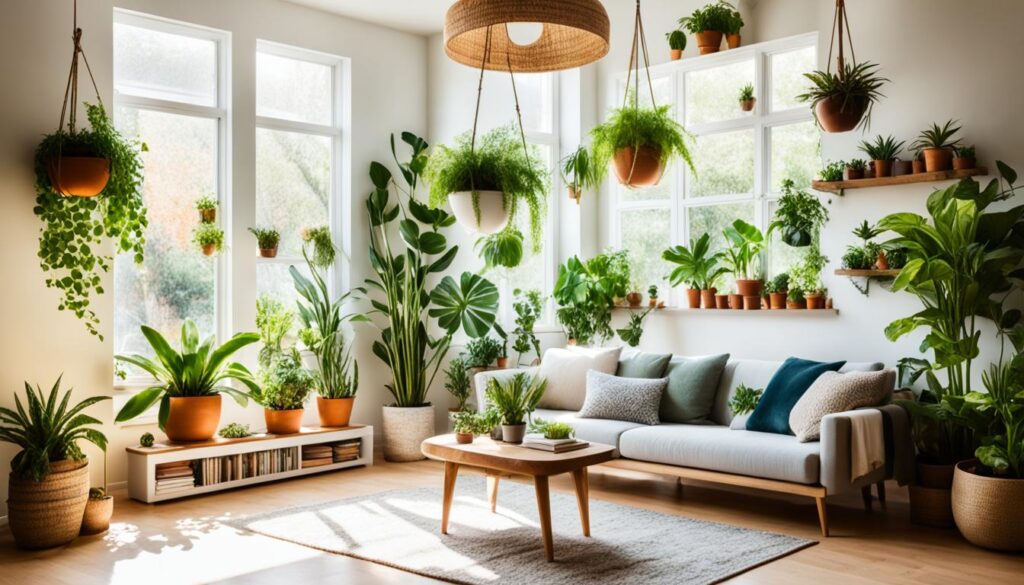
Another creative way to incorporate plant design is by creating vertical walls of greenery. Vertical gardening allows you to maximize space by utilizing the walls of your home. You can choose to install vertical planters or create your own DIY living wall using hanging pots or mounted shelves. Not only does this add a unique element to your home decor, but it also acts as a natural air purifier.
| Plant Design Ideas | Description |
|---|---|
| Collections of little plants | Create a mini garden with a variety of plants |
| Vertical walls of greenery | Utilize the walls in your home for a stunning display |
Terrariums are another popular way to incorporate indoor plants into your home. These glass containers provide a controlled environment for plants, making them a low-maintenance option. You can create a whimsical terrarium by combining different types of plants, rocks, and other decorative elements. It serves as a small ecosystem that adds a touch of green to any room.
If you’re looking for a way to add character to your indoor plant decor, consider using creative pots. Instead of traditional clay or plastic pots, explore unique options like hanging macrame planters, vintage teacups, or repurposed containers. The pots you choose can enhance the overall aesthetic and reflect your personal style.
Consulting with Professional Plant Designers
“Inplantossi, a renowned plant design agency, suggests consulting with professional plant designers to elevate your indoor gardening experience. They provide expert advice on plant selection, arrangement, and maintenance, ensuring your home is transformed into a haven of greenery and tranquility.”
If you’re unsure about how to incorporate plant design into your home or simply want to take it to the next level, consider consulting with professional plant designers. These experts have a wealth of knowledge and experience in creating stunning indoor plant displays. They can guide you in selecting the right plants for your space, suggesting creative arrangements, and providing maintenance tips to ensure your plants thrive.
With the help of professional plant designers, you can transform a room into a dedicated green room, featuring an assortment of plants and unique design elements. This space becomes a sanctuary for relaxation and rejuvenation, allowing you to escape the stresses of daily life and immerse yourself in the beauty of nature.
Incorporating plant design into your home allows you to create a harmonious balance between nature and modern living. Whether you prefer a minimalist approach or an eclectic mix of plants and decorations, there are endless possibilities to explore. Embrace the beauty of indoor gardening and let your creativity flourish.
Conclusion
Enhancing your space with indoor plants is a rewarding and enjoyable process that can significantly improve the overall look and feel of your home. By following the tips and guidance provided in this article, you can create a serene and inviting atmosphere while enjoying the numerous benefits that indoor plants have to offer.
Indoor plants not only add a touch of greenery to your space but also have a positive impact on your well-being. They purify the air, increase humidity, and reduce stress levels, creating a healthier and more comfortable environment. Whether you have a small apartment or a spacious house, there are indoor plants suitable for every corner of your home.
Embrace the beauty of nature and transform your space with indoor plants today. Experiment with different varieties, arrange them creatively, and choose the right pots to complement your decor. The possibilities are endless when it comes to indoor gardening. Discover the joy of nurturing and caring for your houseplants while enjoying the calming presence they bring to your daily life.
So, what are you waiting for? Start your indoor gardening journey and create a vibrant and lush indoor oasis that will leave you feeling reenergized and inspired. With a little love and attention, your indoor plants will thrive, adding life and beauty to your home for years to come.
FAQ
What are the benefits of indoor plants?
Indoor plants can improve indoor air quality, reduce stress, and enhance mental well-being. They also allow for personal expression and creativity in decor choices.
What are some popular indoor plant varieties?
Popular indoor plant varieties include succulents, ferns, and snake plants.
How do I choose the right plants for my space?
Consider factors such as size and lighting conditions when choosing indoor plants for your space.
What types of pots should I use for my indoor plants?
Consider options such as ceramic pots for moisture retention or terracotta pots for better drainage.
How should I arrange my indoor plants on a table?
Vary the heights of the plants, mix different types of plants for texture, and consider lighting conditions when arranging indoor plants on a table.
How do I care for indoor plants?
Proper maintenance and care include watering, lighting, and general care practices. Avoid common mistakes such as overwatering or not providing enough light.
What are the benefits of decorating with indoor plants?
Decorating with indoor plants not only enhances the aesthetic beauty of a space but also improves indoor air quality and reduces stress.
How can I incorporate plant design into my home?
Plant design ideas include collections of little plants, vertical walls of greenery, terrariums, and creative pots. You can also consult with professional plant designers.
